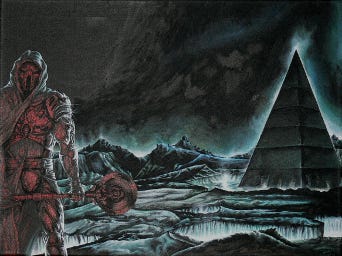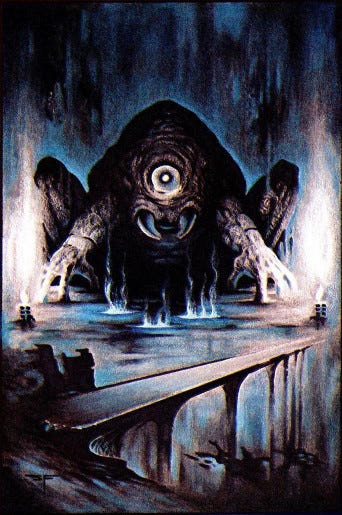(It is yet one of the most potent pieces of macabre imagination ever written. The picture of a night-black, dead planet, with the remains of the human race concentrated in a stupendously vast metal pyramid and besieged by monstrous, hybrid, and altogether unknown forces of the darkness, is something that no reader can ever forget.) H.P. Lovecraft’s review of ‘The Night Land’.
Images From: nightland.website and; Seeing Ear Theatre
Never before, would I have thought Lovecraft did book reviews. Until I read a copy of this story, where his words were written on the back of William Hope Hodgson’s work. To which it shocks me to see that Hodgson, a writer that inspired Lovecraft himself. Has gone so unnoticed in mainstream literature.
But beside that, I want to talk about Hodgson’s work, the night land in particular. With some potential reasons on why he wrote it. And what exactly the messages of the book are.
Published in 1912, the night land was one, if not the first classic of the ‘dying earth’ subgenre of science fiction. And just a true, one of a kind book. With little to no dialogue and a small number of names. To which you never get to know what the main characters name is, only the name of his love, lady Mirdath or Naani, later in the story. Whom the story is written around so on top of sci-fi horror, it’s of a love story to boot. And the whole first chapter paints a picture of their life together in our world, near today, as in, the seventeenth century.
Though the distance of that century to ours is but an eye blink to our time and the time of the main characters reincarnated self. Which is set millions if not billions of years in our earth’s future. Where the sun is blocked from the earth, or out entirely. And I’m sure you’ve read the first paragraph so, Lovecraft can sum up this tale better than I ever could.
But there are things I, and others who’ve read this book have noticed, themes and inspirations I’ll do my best to explain. Since the night land is a difficult and slow read.
First is Hodgsons vivid descriptions in the story. It’s almost a hark back to the book of revelation, as we see the 17th century man attempt to describe the things and hybrid and grotesque monsters, he comes across in the night land, at the end of man. Like saint John, trying his best to tell the reader what he sees in the future, in the end times of our world before the second coming. And this comparison might not be a far cry from Hodgson’s inspiration to write this novel. As his father was a notable ‘fire and brimstone’ type of preacher in the Anglican church.
Plus, this history could mean another source was ‘paradise lost’. A retelling of genesis and lucifer’s fall, written by John Milton. Which happens to have a similar, and mostly narrative driven plot. Not to forget the ‘could be’ connection between Lucifers strong hold in paradise lost. A giant fortress, home to all the fallen angles; Pandamonium. And the last refuge of humanity, a so called ‘last redoubt’. Which is one giant pyramid that houses multiple cities, and many fields in the caverns below it.
Aside from theories, what is this story really about? To which you could simply say it’s a love story. For the story of our unnamed protagonist starts not in the night land. But an old, alluring and sad reminiscence of with life with Mirdath. Whom the mid to late story focuses on, as the protagonist sets out to rescue her in the night from the fallen ‘lesser redoubt’ that was her home.
Though readers from back then, saw the romanticism as overplayed and unnecessary. As do people of today find the archaic language hard to read, and I can to some degree understand. An undoubtedly main reason why this book is not mainstream and is a good chance why there’s no clear message of the story.
Yet, from both my read throughs I got a sense of what could’ve been, as there were supposed to be later work on this story. But not meant to be, as Hodgson died in the first world war. A point I probably should’ve mentioned earlier.
Still, my best guess of this stories message is simply put, time.
For the only thing in this story more frightening than the horrors of the night land is the vast and cryptic history that came before it. A fading sun, a great chasm emerging from the earth. And the erasure of the oceans leading to a massive worldwide rain. All told within the libraries of the last redoubt. But most of all, the inevitable drain of the ‘air clog’, the main lifeline to the last humans that powers all mechanisms of the redoubt. Which we do see faulter in the story through the lesser redoubt, the home of Naani.
And in the end, that’s what we all fear, right? Everything we achieved being decayed over the years. Being slowly forgotten. As were most the deeds of humans before the building of the redoubts. But all for nothing, maybe not. Thats where I do believe, the love story comes in.
Though a little drawn, the couple make it to the last redoubt in the end, living now in peace. Showing us in such a dark world, victory in some way can be reached. Under shadow of such a large threat as the night land, life is still worth living. And the achievements of men and women alike stay on this earth millennia after we go, like an echo through the Aether. All which is only possible through love, and courage.
To send this point and review home, I’ll leave you with the last lines of this great novel.
“And my wife did go forward with me unto the center place of the hall. And Sudden, I saw why she did bring me so cunning sweet. For, there did stand in the midst of the hall, in the place of honor, a statue of a man in broken armor that did carry a maid forever. And you to know how love doth make sweet and brave the heart. And to have understanding with me in my humbleness and my wonder and my natural pride that there did any so think to honor me.
And they that did be there to let me go in quietness with mine own. Which did be a lovely thing of understanding. And I to go loving and thoughtful with mine own wife, and she to be very nigh to me. And I to have gained honor, yet to have learned that honor doth be but the ash of life if not you have love. And I to have love, and to have love is to have all. For that, which doth be truly love, doth mother honor and faithfulness. And they three, to build the house of joy.”
This is but a part of it, a great sum of a long journey through the forgotten earth to aid one true love. A timeless message, that would truly ring through eternity up to the last of mankind, in the furthest reaches.
Thank you.





